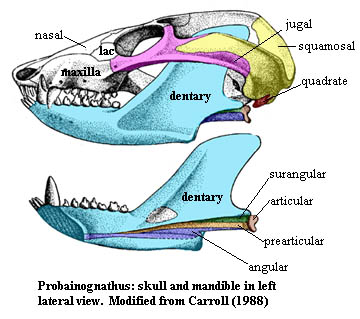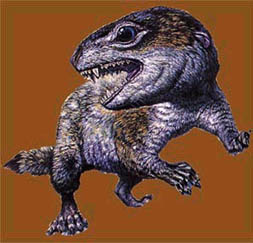 Probainognathia:
Probainognathia:| Cynodontia | ||
| The Vertebrates | Probainognathia |
| Vertebrates Home | Vertebrate | Vertebrate |
Abbreviated Dendrogram
Therapsida
│
└─Cynodontia
├─Procynosuchidae
└─┬─Galesauridae
└─Eucynodontia
├─Cynognathia
│ ├─Cynognathidae
│ └─Tritylodontidae
└─Probainognathia
├─Tritheledontidae
│ ├─Pachygenelius
│ └─Chaliminia
└─Mammaliformes |
Contents
Index |
The Tritheledontids, also and better known (especuially in earlier literature) as the Ictidosaurs, were tiny latest Triassic to Early Jurassic cynodonts that neatly bridge the gap between advanced theriodonts and the primitive mammaliforms.
Although previously separated from other theriodonts as a distinct infraorder, the Ictidosauria, study of the type and only specimen of the genus the Trithelodon has determined its close affinities with the typical Ictidosaurs Pachygenelus and "Diarthrognathus". For this reason, Hopson & Kitching (1972) suggested using the family name Tritheledontidae Broom 1912 for all of the forms called "ictidosaurs", and included all these groups under the Cynodontia.
The Tritheledonts (Ictidosaurs) are thus very advanced, probably insectivorous, cynodonts of small size in which some incisors and in some species the upper and probably postcanines have a transversely-oriented cutting edge, in others the uppers have an oblique and the lowers a longitudinal cutting edge. These are features connected, as in the tritylodonts, with the more efficient chewing of food. As in the Chiniquodontidae the secondary palate is long (so the animal could eat and breathe at the same time, a mammalian feature) and the postorbital bar (the bar of bone behind the eyes) is absent, another feature found also in Tritylodonts and primitive mammals.
But what makes these animals unique is the new mammalian joint between the squamosal and dentary had come into functional being. Thus, the ictidosaur Pachygenelius formerly known as Diarthrognathus) possesses both the reptilian quadrate-articular jaw joint and a newly developed mammalian squamosal-dentary jaw joint. Because of this Simpson (1959) suggested that it might better be classified as a mammal, but Hopson and Crompton retain it in the Therapsida. Although certain primitive features in the skull suggest a derivation from scaloposaurid bauriamorphs, indicating the posisbility that the mammalian condition may have evolved twoice (once from advanced therocephalians via the Ictidosaurs and once from cyndonts via Tritylodonts) But both the structure of the dentary and the braincase structure have independently confirm a cynodont ancestry, and the polyphyly of mammals is no longer considered a valid hypothesis.
Pachygenelius stands truly at the dividing line between cynodont and mammaliform in so far as this important diagnostic feature of jaw articulation is concerned. This is the only reason why the ictidosaurs are classified outside the mammaliformes. In the mammaliforms, the quadrate and articular bones have migrated from the articular region of the jaw to the middle ear where they have been transformed into two of the bones concerned with the transmission of vibrations from the eardrum to the inner ear. Because, in the ictidosaurs, this transformation of the quadrate and articular bones had not taken place, these animals are placed outside the Mammaliformes. MAK010421.
Range: from the Late Triassic?
Phylogeny: Eucynodontia: Cynognathia + *: Tritheledontidae + Mammaliformes.
Characters: $ lack of pineal foramen [RS01]; $ posteriorly elongated secondary palate [RS01]; $ ribs (laterally?) expanded [RS01].
Links: Eucynodontia; Synapsida -- The Dinosauricon; Therapsida all treating Probainognathia as a more inclusive clade).
References: Rubidge & Sidor (2001) [RS01]. ATW020601.
 Tritheledontidae: Theioherpeton, Trithelodon.
Tritheledontidae: Theioherpeton, Trithelodon.
Range: Late Triassic to Early Jurassic of South Africa & South America.
Phylogeny: Probainognathia: Mammaliformes + *: Pachygenelius + Chaliminia.
Small (3-6cm skulls) carnivorous proto-mammals. cheek teeth broad, with prismatic enamel as in mammals; teeth may have been double-rooted; some teeth have transverse cutting edge, others the uppers have an oblique and the lowers a longitudinal cutting edge; probably squamosal-dentary jaw joint and quadrate-articular joint both functional, with masseter and opposing muscles holding jaw in "sling"; postorbital and prefrontal absent; frontal & palatine in contact; temporal opening confluent with orbit; postcranial skeleton said to be fully mammalian.
ATW020223.
Comment: the alternative spelling Trithelodontidae is incorrect MAK121217
Links:Lecture 12 - Early Jurassic; therapsd.htm; CIENCIA HOY 32 - ARTÍCULO; traces; JawTransition; JURASSIC CYNODONTS; Tritylodontidae and Tritheledontidae, an internet directory. Wikipedia
References: Luo et al. (2002) [L+02]
Image: "Diarthrognathus" from Argentine Museum of Natural Sciences.
Notes: [1] According to [L+02] the characters that support tritylodonts as the sister of mammaliforms are strongly localized to the orbital wall and sphenoid region. Characters of the jaw joint, mandible and palate point to tritheledonts. ATW020223.
 Pachygenelius: P. monus Watson 1913; P. broomi Crompton 1958 (= Diarthrognathus broomi).
Pachygenelius: P. monus Watson 1913; P. broomi Crompton 1958 (= Diarthrognathus broomi).
Range: Early Jurassic of South Africa, possibly North America. P. monus: Red Beds and Cave Sandstone (Middle and Upper Elliot Formation), Orange Free State, Red Beds and Cave Sandstone (Middle and Upper Elliot Formation), Orange Free State and Lesotho, South Africa, of Hettangian to Sinemurian age. P. broomi: Clarens Formation, Orange Free State, South Africa, of Sinemurian / early Pliensbachian age.
Phylogeny: Tritheledontidae: Chaliminia + *.
Image: Pachygenelius jaw (~2 cm), Parrsboro, Nova Scotia. From the Nova Scotia Museum Fossils of Nova Scotia Website. © 1998 Nova Scotia Museum and used by permission.
Links: parrs.htm; Tritheledont tooth; JURASSIC CYNODONTS; Tritylodontidae and Tritheledontidae, an internet directory; UNIVERSIDAD CAECE- Cursos y Seminarios.
Notes: [1] Pachygenelius ?monus has also been reported from the Early Jurassic of Nova Scotia. But while it is not unlikely that this jaw might belong to Pachygenelius (or a similiar form), a species attribution, or even an unambigious genus attribution, is very unlikely. [2] Diarthrognathus broomi is based on two juvenile specimens which are possibly, though not certainly, referable to P. monus. This then is either a synonym of the earlier P. monus or a distinct but closely related species, probably a descendent. Although a specific distinction may prove to be valid, it is doubtful that generic differences exist. MAK010421. ATW020601.
Chaliminia: C. musteloides Bonaparte 1978.
Range: Late Triassic to Early Jurassic of South America, Los Colorados Formation, Argentina, of late Norian to Hettangian age.
Phylogeny: Tritheledontidae: Pachygenelius + *.
Links: Tritheledont tooth; JURASSIC CYNODONTS; Tritylodontidae and Tritheledontidae, an internet directory; UNIVERSIDAD CAECE- Cursos y Seminarios.
Notes: The only known Triassic tritheledont, and part of a highly endemic fauna, which makes it difficult to correlate. However although the Los Colorados Formation is usually considered latest Triassic (Late Norian /Rhaetian), Jose Bonparte says somewhere (I can't find the exact passage...) that the fauna may not be isochronous. So it is possible that the upper part of the Los Colorados may be Hettangian (earliest Jurassic). That would fit in Chaliminia with the other tritheledonts. MAK010421. ATW020601.
checked ATW021027, last modified MAK121217